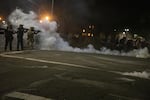
Federal law enforcement officers fire impact munitions and tear gas at protesters demonstrating against racism and police violence in front of the Mark O. Hatfield federal courthouse in Portland, Ore., on July 16, 2020.
Jonathan Levinson / OPB
Even as they announced a striking agreement Wednesday to remove federal officers from Portland streets, Gov. Kate Brown and Trump administration officials kept up the rancorous posturing that has characterized the past three weeks.
With the deal to swap out the “occupying force” of federal border patrol and immigration officers for Oregon state troopers, Brown announced to the world she’d bent the Trump administration to her will.
“The federal government has agreed to my demand and will withdraw these officers from Portland,” she said.
Acting Homeland Security Secretary Chad Wolf, meanwhile, downplayed any withdrawal of his officers. He insisted officers would remain in the area, and that he’d brought Oregon officials to heel by forcing them to protect Portland’s federal courthouse.
“This is a presence,” he said, “that we have been asking for for the past 60 days.”
The starkly different perspectives would shock few people who’ve watched drama and unrest unfold on Portland streets. But the way state and federal officials sought a way out of the cycle of nightly violence that has captivated the country is surprising.
According to Brown’s office and others, what unfolded behind the scenes over the course of three days was a series of courteous — even “affectionate” at times — conversations that led to an agreement for how federal agents would leave the city.
“They wanted this to end, too,” said Nik Blosser, Brown’s chief of staff, who on Wednesday walked OPB through the effort behind the agreement. “They are working 21-hour days, and they want to get out of this. We had comfort that regardless of what gets tweeted out, the operational aspects are in alignment.”
An unlikely ally
The stalemate between state and federal officials began in early July, not long after the Trump administration sent an influx of law enforcement from an array of agencies to Portland to, in the president’s words, “quell” ongoing protests.
Instead, federal officers only incited protests further, drawing widespread condemnation when questionable detentions and violence against demonstrators became a nightly spectacle. Tear gas, flash-bangs and impact munitions have seen frequent use since federal agencies arrived.

Demonstrators clean tear gas from their eyes outside the Mark O. Hatfield federal courthouse in Portland, Ore., July 25, 2020.
Bradley W. Parks / OPB
State and local leaders called on the federal government to pull back its forces immediately. Federal officials declined, repeatedly decrying “violent mobs” of demonstrators they said were bent on burning its property to the ground.
As recently as Monday, there seemed to be no end in sight, and federal authorities were even planning to send reinforcements into the city.
But according to Blosser, the first glimmers of a deal actually emerged last Thursday, July 23. By that point, Brown had been inveighing for a week against the president’s decision to send a surge of federal law enforcement to Portland in order to protect the federal courthouse from vandalism.
Although the protests have been largely peaceful, some protesters have set fires near the courthouse and others have thrown rocks, water bottles and commercial-grade fireworks at federal officers.

Fireworks go off outside the boarded up federal courthouse during 4th of July demonstrations against systemic racism and police violence in Portland, Ore.
Jonathan Levinson / OPB
Brown and state police Superintendent Travis Hampton, had concluded that simply demanding federal forces leave wouldn’t work. They needed to offer something in return.
Hampton drew up a proposal that would allow his troopers to replace the fatigues-wearing Customs and Border Protection officers whose behavior had caused most of the outcry among Portlanders. And Brown tried to reach a senior federal official for whom she’s developed an unlikely appreciation in recent months.
She contacted the office of Vice President Mike Pence.
According to Blosser, Brown and Pence have forged a bond in regular conversations over coronavirus response. Their spouses know each other, and Pence, a former governor of Indiana, can relate to Brown.
“There’s some affection for each other,” Blosser said. “They have a good relationship.”
But the vice president was not available last Thursday when the governor reached out.
That night, as usual, thousands of protesters massed in a small section of Portland’s downtown core to protest police violence and racial injustice. The demonstrations gave way to tear gas and impact munitions.
The first indication that the White House might be willing to work with Brown came Sunday, when Blosser says he got word that Mark Meadows, the chief of staff to President Trump, wanted to speak with the governor.
A series of meetings
The next day, the real discussions began.
At 8:30 a.m. Monday, Brown was on the phone with Pence as he sat aboard Air Force Two.
“What she basically said was, ‘I need someone I can negotiate with on this. We have a concept,’” said Blosser, who listened in on the call.
The conversation, according to Blosser, was warm. Brown expressed concern someone was going to be killed in the nightly clashes. Pence, too, worried escalating violence might lead to a death.
Pence also voiced an admiration for Mark Hatfield, the former Republican U.S. senator from Oregon and the namesake of the city’s federal courthouse.
“They talked about how he stood for peace and justice,” Blosser said. “Neither of them wanted this happening in front of his name on the courthouse.”
Plus, Pence told Brown, he had an affinity for state troopers from his time as a governor. He closed the call by saying he would do a “download” with Wolf, the acting homeland security secretary.
Not long after noon on Monday, Brown was on the phone with Meadows. Once again, Brown walked the president’s top aide through the plan. According to Blosser, Meadows said he’d already been over the proposal with Wolf and Attorney General Bill Barr “and they agreed with the approach.”
At 4 p.m. Brown set up a meeting with more senior administration officials — this time in person. FBI Deputy Director David Bowdich and Rudolph “Tex” Alles, the undersecretary of management at DHS, had come to Portland because of the ongoing tensions.
Hampton, the state police leader, explained his idea by phone. According to Blosser, they too agreed it would work. The entire meeting was completely courteous, he said, regardless of the steep divide officials on both sides of the issue were expressing publicly.
“Basically over the course of that 12-hour period Monday we kind of had worked things out,” Blosser said.
‘Approval from one person’
By Tuesday, the governor’s office was ready to meet with the city of Portland.
Shortly before noon, Brown's office sat down with Portland Mayor Ted Wheeler, Commissioner Jo Ann Hardesty and Portland Police Chief Chuck Lovell to discuss the proposal with them.
The conversation came on the heels of a request from Wheeler and Hardesty to the Department of Homeland Security seeking a “cease fire” to end the federal deployment. They never got a response.
As it happened, the meeting was the first time Portland officials learned of Brown’s efforts. “We wanted to make sure it was going to work with the feds first,” Blosser said.
According to the governor’s office, city officials were overwhelmingly supportive of the plan. Their response was along the lines of, “Thank you. Bless you. Absolutely support this strategy,” Blosser said.
Sonia Schmanski, Wheeler’s deputy chief of staff, said Wednesday the conversation over removing federal officers was ultimately one the governor needed to have. The Portland City Council had taken an aggressive stance against the agents’ presence, Schmanski noted, which made communication less likely between the city and federal government. Plus, state resources were a necessary part of the equation.
“People were really happy to know [the governor] had engaged and it had been productive,” she said.
Brown also spoke twice on Tuesday with Wolf about aspects of the arrangements, conversations that Blosser said were “not as courteous” as her discussions with other administration officials.
Given the progress they’d made with federal officials, Brown’s office was hopeful it could announce a deal by Tuesday evening. But approval from Washington, D.C., for green-lighting the agreement came slower than they’d hoped. The governor’s office believes that administration officials were awaiting word from the president, who had repeatedly blasted Oregon leaders on Twitter and in media appearances.
“They said they needed approval from one person,” Blosser said. “That was the implication. That’s how we interpreted it.”
A text finally arrived on Blosser’s phone at around 8 a.m. Wednesday. Wolf’s chief of staff wanted to talk by phone. The deal had been approved.
Changing the mood
Even so, the president’s rhetoric remained acrimonious.
On Wednesday morning, Trump tweeted: “If the Federal Government and its brilliant Law Enforcement (Homeland) didn’t go into Portland one week ago, there would be no Portland -- It would be burned and beaten to the ground. If the Mayor and Governor.....do not stop the Crime and Violence from the Anarchists and Agitators immediately, the Federal Government will go in and do the job that local law enforcement was supposed to do!”
...do not stop the Crime and Violence from the Anarchists and Agitators immediately, the Federal Government will go in and do the job that local law enforcement was supposed to do!
— Donald J. Trump (@realDonaldTrump) July 29, 2020
The broadside wasn’t unexpected. Blosser said there was a clear acknowledgement when crafting the announcement for the deal that each party would communicate the agreement in divergent ways.
“Because we have different audiences, the audience on Fox News is different from the people in Portland,” he said. “Everyone knew they had to declare victory. We’re going to talk about the same set of facts but we’re going to talk about them differently.”
When the deal was finally announced at 8:30 a.m., both sides sounded like the winner — for very different reasons.
Federal officers will begin to leave Thursday. No one claims to know what happens next.
Wolf and Trump have said they won’t hesitate to send law enforcement back into the streets if they aren’t convinced the courthouse is being protected. Blosser believes that state troopers will be able to provide a steadying hand; the governor said they’ve been ordered to avoid confrontations with demonstrators.
“There is an expectation there will be a significant de-escalation and very much a changed presence,” Blosser said.
As part of the agreement, the graffiti that for weeks has adorned the courthouse in epithets will be removed. A reinforced fence that has become a central target of demonstrators will come down. It's not completely clear when either will happen.
According to Blosser, Brown does not expect the protests over police violence and racial injustice — a feature of Portland’s landscape for more than two months at this point — to go away, simply because some federal officers are departing.
But, he added, “we have to change the whole mood of this.”